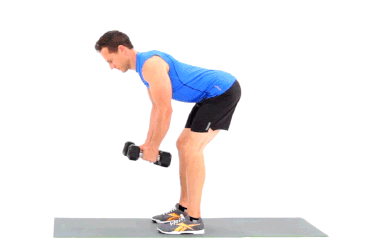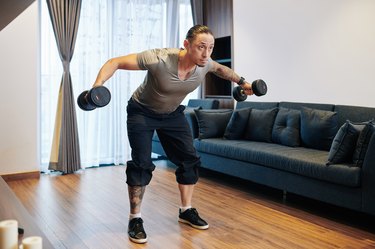

Like the top shelf of your snack cabinet, your rear shoulder muscles (aka rear delts) are hard to reach.
Fortunately, the dumbbell rear delt fly — also called the dumbbell rear delt raise — makes isolating these often and easily-neglected muscles much easier.
Video of the Day
- What is a rear delt fly? It's a shoulder exercise that you can do with dumbbells, a cable machine or pec dec machine. This move involves raising weights to your sides in an arching motion.
- What muscles does this move work? The main target of the exercise is your rear delt muscles, which sit in the backs of your shoulder. But this move will also strengthen your traps (the muscles around your neck and upper back) and rhomboids (the muscles between your shoulder blades).
- Who can do a rear delt raise? Anyone dealing with shoulder impingement or pain should avoid doing this exercise, according to New York-based certified personal trainer Carolina Araujo, CPT. It's probably best to skip the bent-over version of this exercise if you're dealing with lower back pain, too. Doing this move standing with cable machine may be more comfortable.
Ready to build your shoulders and upper back? Here's everything you need to know about the rear shoulder fly.
How to Do a Rear Delt Fly With Dumbbells
To get the most out of this exercise and keep your shoulders safe, good form is key. Learn how to do this exercise with these step-by-step instructions.
Dumbbell Rear Delt Fly
- Begin standing with your feet hip-width apart and hold a dumbbell in each hand.
- Push your hips back behind you and bend your knees slightly as you lean your torso forward with a flat back. Maintain this hip-hinge position throughout the exercise.
- Let the weights hang down toward the floor with your elbows slightly bent and palms facing each other.
- Keeping your shoulders down away from your ears and a slight bend in your elbows, lift the weights out to your sides until they're in line with your shoulders.
- Lower the dumbbells with control.
Tip
To make sure you're hitting the right muscle, keep the motion slow and controlled.
"[The rear delt] is a pretty hard-to-reach muscle, so your form is important when you do this exercise," Araujo says. "It's best to start with a light pair of dumbbells and do 10 reps. Then as you get more comfortable with the exercise, you can increase weight."
For your first crack at this exercise, grab a pair of 5-pound weights. This may sound light, but it will probably be harder than you think. And if you struggle to maintain good form, grab smaller dumbbells.
4 Rear Delt Fly Benefits
1. Strength and Endurance
The rear delt raise increases your strength and endurance. Unlike some other isolation exercises (moves that target just one muscle), this strength move works several upper-body muscles at once.
Plus, when you perform it in a bent-over position, you also work your quads and core, Araujo says.
2. Improved Posture
If you spend much time hunched over your phone or computer, you likely have some posture issues, including a rounded upper back, according to the National Academy of Sports Medicine (NASM). Having weak upper back and rear shoulder muscles adds to the problem.
Strengthening your backside can help fix muscle imbalances to improve your posture, Araujo says. That change in position can also help alleviate shoulder and headaches.
3. A Healthy Body Composition
Including more strength-training exercises in your weekly workout routine can help increase your body's levels of lean muscle mass.
Building muscle can also help speed up your metabolism (the rate at which your body burns calories), according to the Mayo Clinic.
4. Stronger Bones
Weightlifting exercises stress your bones, according to Mayo Clinic. This may sound like a bad thing, but it can actually increase your bone density, reducing your risk of developing conditions like osteoporosis.
5 Shoulder Fly Mistakes
There are a few common mistakes people make while doing the exercise. Keep an eye on your form to avoid these errors.
1. Curving Your Spine
To target your rear deltoids, you need to keep a long, neutral back. But many people curve their back, says California-based physical therapist Jereme Schumacher, DPT.
"This position alone can be difficult to maintain due to the demand of your hip and core muscles," he says. It can also dump extra, potentially painful, stress into your lower back.
Tip
If you struggle to maintain this hinge position, Schumacher recommends you do this exercise lying face-down on an incline bench to give your midsection extra support. (More on that below.)
2. Straightening Your Elbows
Although your arms come up to shoulder height with this exercise, you don't want to make a perfect "T" shape. Locking out your elbows can add unwanted stress on your joints, leading to aches or injuries in the long run.
Tip
Keep a micro bend in your elbows as you lift the weights to avoid any damage to the joints.
3. Lifting Too Heavy
We can't say it enough: Don't start heavy with this exercise. Control is the goal.
"If you are really trying to isolate your rear deltoids, you have to make sure the weight isn't too heavy," Schumacher says. "If the weight is too heavy, you will have to [use] other muscles to complete the movement."
Tip
Start with 5-pound dumbbells until you are confident you can move more with good form, Schmacher says. Try to increase your weights in 2.5-pound increments.
4. Using Momentum
Another reason you want to start with lighter weights? You don't want to rely on momentum to lift the dumbbells.
During this exercise, you don't want to feel your knees dipping and back rising with each rep. Instead, focus on keeping your back totally stable with your core braced.
Tip
You can modify the exercise on a bench (more on that below) if you struggle to keep your upper body stable in the bent-over position.
5. Scrunching Your Shoulders
When you fatigue, your form inevitably falters. Often, after too many reps of this exercise, your upper back and neck muscles (traps) start to take over, scrunching your up to your ears as you lift the weights.
Tip
Bring down your rep range and focus on squeezing your shoulder blades down and together. If you notice your shoulders hiking up, it's probably best to wrap up your set.
4 Rear Delt Raise Modifications
1. Use an Bench
You can set an exercise bench to a low incline and lean your chest onto the bench with your feet planted on the floor around the seat, Araujo says. The bench gives you a little extra stability and eliminates the possibility of using momentum. You can also use a flat bench.
2. Do It Seated
If your legs or lower back get tired, try the exercise from a seated position. Just sit at the end of a bench or chair, lean forward with a flat back and do your raises, she says.
3. Use the Reverse Pec Deck
You may use the pec deck machine in your chest workouts, but it actually doubles as a rear delt machine, too. Using it for your reps can help you better isolate your rear shoulders.
Sit on the machine with your chest against the back pad and adjust the handles so that they're both right in front of you.
"This allows you to grab the peg handles ," Araujo says. "Once you're set up, you just repeat the same motion as with dumbbells."
4. Try the Cable Machine Reverse Fly
If you have lower back pain, doing this move from a standing position can help. To work your rear delts while standing, use a cable machine.
To set up a cable machine reverse fly, you'll need two cables side by side, adjusted to the highest level, Araujo says. With no attachments clipped in, grab the right cable with your left arm and left cable with your right, holding your arms in an X shape in front of you at shoulder height.
Then, just pull your arms apart until your fists are in line with your shoulders. Keep a slight bend in your elbows at all times.
Dumbbells vs. Machines
"There's no rule when it comes to using dumbbells or machines. It all comes down to preference and which allows you to more effectively hit this muscle," Araujo says. "For some people, they may not be able to activate their rear delts with dumbbells as easily as with a pec deck. You want to listen to your body and see which feels best."
3 Rear Shoulder Raise Progressions
1. Lift With One Arm
Challenge your core stability by doing all your reps on one arm only, Araujo says. Once you finish all your reps, switch sides.
2. Add an Isometric Hold
"Rear delt flys are all about control, so this progression is quite the challenge," she says. As you lift the weights, pause when your elbows are in line with your shoulders. Hold at the top of the motion for a few seconds before you slowly lower the weights back down,
3. Combine the Two
This progression involves single-arm work and pausing at the top. What you'll do is lift both weights to the top of the motion and pause. Hold your left arm in place and do all your reps with the right arm. Then, lock the right arm in place while you finish your repetitions on the left.
"This one really burns so don't be shocked if your arms are a little shaky at the end" Araujo says. You'll need to use a lighter weight than you usually do.